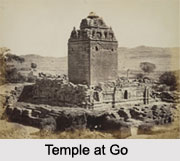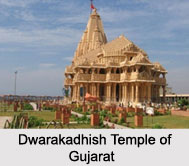 Temple Sculpture of Western India is still permeated with much of the vitality and sensuousness of Gupta times, with an appended element of baroque overstatement, while the actual material of the temple lends itself more sculptural treatment. Highly observational, diverse, prosperous and even flamboyant, sometimes scattered, the temple architecture and to a lesser amount, sculpture of the Gupta period is the most stirring in all Indian art and in western India it can be still be seen in comparative large quantity.
Temple Sculpture of Western India is still permeated with much of the vitality and sensuousness of Gupta times, with an appended element of baroque overstatement, while the actual material of the temple lends itself more sculptural treatment. Highly observational, diverse, prosperous and even flamboyant, sometimes scattered, the temple architecture and to a lesser amount, sculpture of the Gupta period is the most stirring in all Indian art and in western India it can be still be seen in comparative large quantity.
Features of Temple Sculpture of Western India
A number of interesting and normally tiny shrines in Saurashtra, in the southwest corner of Gujarat, may include the oldest surviving structures in western India-unless. They are predominantly bhiimiprasadas, somewhat pyramidal, with tiers of kapotas, exemplifying storeys and a baffling assortment of other components- in the corners, small square pavilions, normally in the southern form; alternate with amalakas and on certain occasions the superstructure is topped by a Dravida shikhara, Gavasakas, simple unembellished and of a size and audacity quite unknown at the time elsewhere in India, lend these temples a stark individualism, though the common effect of their plain walls, without recesses or expression and with trivial or no carving, is rather terrible. There were more conservative Nagara superstructure sanctums and halls are nearly enclosed by a single rectangular wall and the superstructures are more Dravidian compared to Nagara.
Different Temple Sculpture of Western India
The supreme temples in Western India, though, dated from the 10th century. Some of the noted temple sculptures of western India are as follows;
Ghatesvara Temple: The most significant of which is the Ghatesvara temple at Badoli. The effortless but beautiful Badoli temple consists of a chamber with a curved superstructure and an open hall with six pillars and two pilasters supporting a pyramidal spire. Only the mid projections of the chamber walls are decorated with positions containing monument.
Ambika Mata Temple: The Ambika Mata temple at Jagat, of the mid-10th century, is extremely fine. It consists of a chamber, a surrounded hall and walls covered entrance with projecting eaves. The walls of the chamber and the hall are covered with fine sculpture, the superstructures being of the curvilinear and pyramidal types.
 Temple at Gop: The temple at Gop has three extensions on a side, incorporating recesses. A wall painting of garyas is another early western Chalukya feature. The entryway appears to have been unadorned. Its inimitable and exceedingly graceful superstructure, comprising two sloping rectilinear roofs superimposed, the lower bearing two tremendous gavasakas to a side, the upper one a single one, is the earliest instance of a phamsana roof. The slight sculptural ruins at Gop comprise images of Lord Vishnu and a Skanda, two door keepers, Rama and a seated woman in one of the gavasakas of the roof. The style suggests a late 6th century date and, as with some of the other temples, a link with the early western Chalukyas.
Temple at Gop: The temple at Gop has three extensions on a side, incorporating recesses. A wall painting of garyas is another early western Chalukya feature. The entryway appears to have been unadorned. Its inimitable and exceedingly graceful superstructure, comprising two sloping rectilinear roofs superimposed, the lower bearing two tremendous gavasakas to a side, the upper one a single one, is the earliest instance of a phamsana roof. The slight sculptural ruins at Gop comprise images of Lord Vishnu and a Skanda, two door keepers, Rama and a seated woman in one of the gavasakas of the roof. The style suggests a late 6th century date and, as with some of the other temples, a link with the early western Chalukyas.
Shiva Temple: The Shiva temple at Kusuma, west of mount abu, known as the Ramachandraji, is still a work of enormous essence and exquisiteness. It has similarities with early western Chalukya temples of the 7th and 8th centuries comprise the central pillars with brackets supported by the protruding busts of youthful figurines. Nothing beats the excessive marble sculpturing developed by the Jains at their temples. The jain temples have large statues of their tirthankaras enshrined in the sanctum. Jain temple architecture is characterized by its profusion of sculpturing. The best examples are at Mount Abu and Ranakpur. Ranakpur consists of a fortified complex of temples that arose in Mewar. The temple of Adinath is characterized by its excess sculpture.
Dwarakadhish Temple: Dwarakadhis Temple of Gujarat is dedicated to Lord Krishna. It consists of sixty carved pillars and a number of sculptures that depict the influence of various dynasties such as the Guptas, Pallavas and Chavdas (referring to Chavda Kingdom) that ruled Dwarka over the years. The Sun Temple, Modhera, Gujarat is dedicated to Sun God that was built during the rule of Solanki dynasty. This temple is also known for its erotic sculptures. Hinduism, Buddhism and Jainism have presented erotic motifs in their art. Intimate scenes have been displayed, at the exterior walls of the main temple itself.
Kailasanathar Temple: The Kailasanathar Temple is located in Maharashtra and the structure seems to belong to the Pallava kingdom. The arcades have huge sculpted panels and alcoves containing enormous sculptures of several deities. Lower stories of the Nandi Mandap are solid structures, decorated with elaborate illustrative carvings. The grand sculpture of Ravana who is shown trying to lift Mount Kailasa is remarkable.
Rankadevi Temple: The Rankadevi temple at Wadhwan of the early 10th century is also described by plain walls and a pyramidal spire, while the Shiva temple at Kerakot has a combined spire and also a mandapa.
The Rudramala at Siddhapur, the most wonderful Gujarati temple of the 12th century, is now in a much ruined condition, with only the torana (gateway) and some contributory structures outstanding. The temples at Kiradu in Rajasthan, dating from the 10th and 11th centuries, show a progress towards rising embellishment and decoration.



